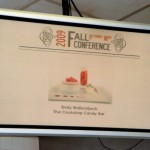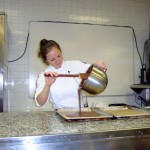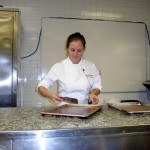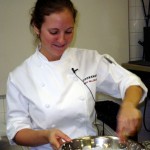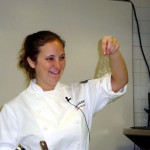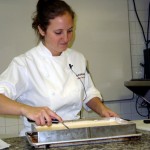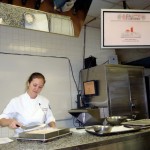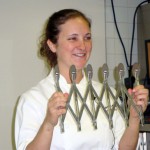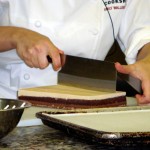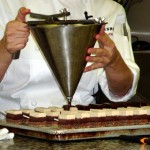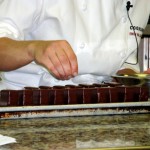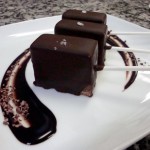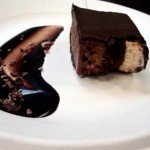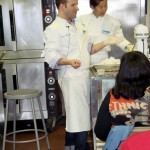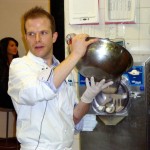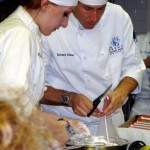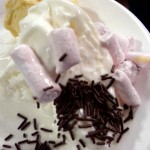PastryScoop’s Fall 2009 Conference
My beloved French Culinary Institute & PastryScoop.com held their annual conference in October. They invite some of the best pastry chefs & chocolatiers in New York to come and do demonstrations of their signature treats. It’s open to the public, so I ponied up $65 to watch Cookshop’s executive pastry chef Emily Wallendjack make her famous Cookshop Candy Bars, with layers of Devils food cake, gianduja crunch, praline ganache, frozen peanut nougat, and chocolate shell. She invented these after her stint at Jean-Georges working with pastry chef Johnny Iuzzini. Chef Johnny made a wonderful peanut butter dessert that cemented her love of peanut butter and chocolate. (I don’t blame her– Reese’s Peanut Butter Cups are a guilty pleasure of mine.) She joked that if she ever dropped her Candy Bars from the menu, her customers would have her head. Once I tasted the completed confection, I understood why:
It was such a delight to watch her and her team work. She gave us the complicated recipe to follow-along with and make at home ourselves (hah!). She explained everything patiently, clearly, and with humble humor. Her sous chef, Natasha Hillendahl, was so efficient. Cake would get baked, chocolate would get melted, and needed cooking implements would appear by Chef Emily’s side without a word.
I learned the following random baking tidbits along the way:
-Gianduja is milk solids & hazelnuts, which civilians can purchase at Whole Foods and is made by Valrhona.
-Mayo (I know, ew!) actually works better than oil in cakes because it incorporates better. And yes (double-ew!!), you can use Hellmann’s. Chef Emily uses mayo in her Devils food cake.
-When making ganaches, it’s better to use a heat-proof spatula than a whisk so you don’t incorporate air bubbles. Also, using milk chocolate is dicey because it burns much faster than dark chocolate.
-Water is one of chocolate’s worst enemies, as it causes it to sieze up. When using a double-boiler to melt chocolate, make absolutey sure there’s a tight seal over the water, don’t let the water boil, and look out for condensation.
-Gelatin sheets (available at Buon Italia in the Chelsea Market) are great, flavorless thickeners. You put them in ice water to soften and wigglify. Then you squeeze them out before you use them.
-It’s good to whip cream with side-to-side motions using a flat whisk. It’ll still take forever, though!
-Pâte à glacer is just chocolate & grape seed oil, and is used to make chocolate coatings. You don’t refrigerate it.
-Chocolate “feet” form when you’re coating something, and it flattens and cools on a surface. Tasty feet!
After Chef Emily was done, I asked her what her favorite dessert was to make: “ice cream and sorbets,” she said. She loves experimenting with different flavors and selling them at their sidewalk stand outside the restaurant, where they don’t need a permit and are in a prime spot for High Line foot traffic. I get the sense that ice creams are the preferred form of expression for many pastry chefs. It certainly seems like those Iron Chef guys just can’t stay away from the ice cream makers. Lobster and shiitake sorbet, anyone?
After the Cookshop demo was over, I saw that next door’s Ice Cream Social with Flex Mussels’ corporate pastry chef Zac Young was still rockin’. I snuck in and was immediately struck by the frenetic atmosphere of the room. Chef Zac was making seemingly endless varieties of ice cream and sorbet, and his sous chef and the poor FCI students were busting their butts to keep up. I got to try the cream cheese ice cream and white chocolate mint and passion fruit sorbets, but I think my palate was shot by then or I was too full, because I didn’t find the flavors to be well-balanced; maybe they just weren’t sweet enough to my liking.
Looking forward to seeing who’s coming out next year! And, as always, I can’t wait for my next trip to L’Ecole, FCI’s amazing student-run restaurant.
No comments yet.
